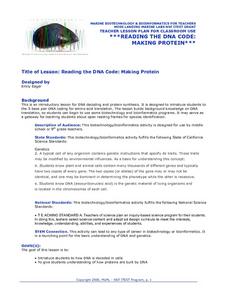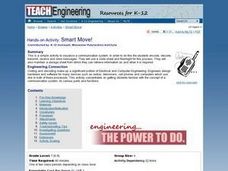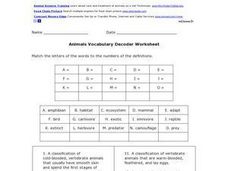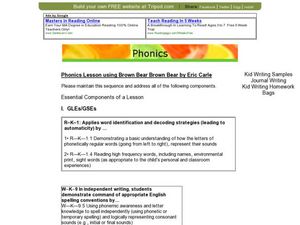Curated OER
Magnetism-Decode Encrypted Statements
Third graders solve a cryptogram by decoding a message written with wingdings. In this decoding instructional activity, 3rd graders solve a message related to magnetism. Students have notes about magnets once they've finished.
Curated OER
Reptiles and Amphibians (1)
For this animals worksheet, students practice decoding the names of 14 different types of reptiles and amphibians. Students write their answers on the lines provided on the worksheet.
Walt Disney Company
Disaster Preparedness Activity Book
Join the American Red Cross as well as Mickey and friends as they help to prepare young scholars for natural disasters. After reading brief informational passages about earthquakes, floods, fires, storms, tornadoes, and hurricanes,...
Curated OER
Reading the Dna Code: Making Protein
Students study DNA decoding and protein synthesis. They use the amino acid table to translate DNA, break DNA strands into three nucleotide codes, and translate nucleotides into amino acid protein codes. They research the importance of...
Curated OER
Outer Body Parts Decoder
In this outer body parts activity, 1st graders analyze and decode 32 scrambled outer body parts by utilizing the letter decoder found on the top of the activity.
American Institute of Physics
The Tuskegee Weathermen: African-American Meteorologists during World War II
Chances are good that young scholars have heard of the Tuskegee Airmen but few would predict that these pilots had their own support in the form of the Tuskegee Weathermen. These Black meteorologists were recruited and trained to provide...
Curated OER
Communications: To the Rescue!
Students role-play as soldiers rescuing lost mountain climbers. Working in teams, they interpret maps to locate the climbers and use flashlights to send and receive coded messages about the rescue. Their goal is to complete the task in...
Curated OER
Decoding DNA
Third graders complete their KWL charts from the first lesson of the unit as a review for the summative. Then they decode a secret message using the four basic components of DNA, adenine, cytosine, guanine and thymine.
Curated OER
Rain
First graders practice oral and silent reading using beginning comprehension and decoding strategies. In this guided reading instructional activity, 1st graders take a picture walk and make plot predictions prior to reading the...
Curated OER
Decoding a Mystery Message from Space
Students examine a message sent from outer space and do their best to interpret its meaning. In this problem solving lesson plan, students investigate a code sent to them from "outer space." The students collaborate with their classmates...
Curated OER
Weather Words Decoder (Easy)
Kids love a mystery! There are 11 sets of numbers, and each number translates to a certain letter. To find the word, learners have to record which letters are associated with which numbers. The theme is weather related vocabulary and...
Curated OER
Tomato Exploration
Create tomatoes in 15-20 minutes using this fun and interactive lesson plan! Learners listen to a book about tomatoes (recommendations listed), and focus on the vocabulary word tomato. They count the syllables...
Curated OER
Animals Vocabulary Decoder Worksheet
Add some decoding to your scholar's review of basic life science terms in this decorder activity, where students match 15 words to their definitions. Words such as mammal and amphibian must be matched to their written definition. The...
Curated OER
Secret Codes
Students practice writing and decoding secret messages before discussing DNA and its role as a code for making proteins. They translate DNA into RNA and identify the sequence of amino acids to find a secret message. An interactive...
Curated OER
Cracking the Code
Students explore encoding systems and decoding technology. In this barcoding lesson plan students examine how coding impacts society including distribution, and inventory.
Curated OER
Binary and Communication Systems
Students participate in an activity that introduces them to the concept of binary coding as a language. They decode messages using special boards that has its own code for different letters. They create new codes by rearranging wires...
Curated OER
A Good Scientist Can . . .
In this scientist worksheet, students use a decoding system to determine the characteristics of a good scientist. Students decode 16 terms.
Pearson
Transcription
Teach young biologists the language of life with this series of worksheets on DNA. By working through these pages, students expand their understanding of genetics as they learn about the process of transcription and the...
Curated OER
Guided Reading Organizer for Chain Reaction
The class uses Chain Reaction, a magazine, to build a better understanding of Latin and Greek roots found in scientific vocabulary. They use two attached worksheets to help them read a scientific article, using visual clues and their...
Curated OER
Replication, Transcription and Translation Review
How well do your pupils understand DNA, mRNA, and amino acids? This three-page handout will help you assess their comprehension through sequencing questions, fill in the blanks, and labeling diagrams.
Curated OER
Smart Move!
Students visualize a communication system. They encode, decode, transmit, receive and store messages. Students use a code sheet and flashlight for this process. They will also maintain a storage sheet from which they can retrieve...
Curated OER
Condon Bingo
Students use COndon Bingo to decipher genetic codes. Students practice transcription and translation of codons while playing the game. They enjoy playing the game, while actively participating. Students develop an increase proficiency...
Curated OER
The Stroop Effect
Students explore the specific areas of the brain that process different types of information. They examine processing conflicts. Students participate in a hands-on minds-on activity using the Stroop Effect. They design psychological...
Curated OER
Brown Bear Phonics
Students listen to Brown Bear, Brown Bear and imitate the style of Eric Carle in writing a sentence. In this writing lesson, students use the beginning and ending sounds of words to write an Eric Carle type sentence. ...
Other popular searches
- Decoding Unfamiliar Words
- Decoding Long Words
- Decoding Multisyllabic Words
- Decoding Accented Words
- Decoding Animal Words
- Decoding Vowel Words
- Decoding Spelling Words
- Decoding Multi Syllable Words
- Decoding Greek Latin Words
- Decoding Big Words
- Decoding Polysyllabic Words
- Decoding Unknown Words























